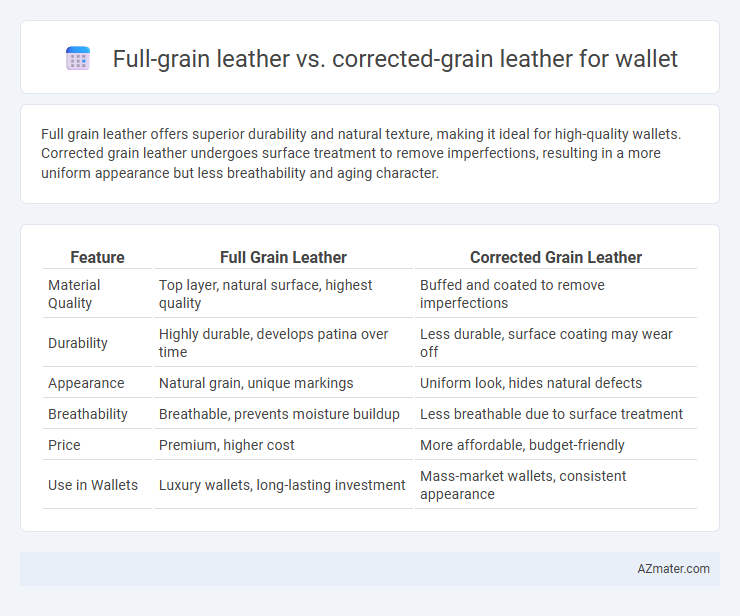Full grain leather offers superior durability and natural texture, making it ideal for high-quality wallets. Corrected grain leather undergoes surface treatment to remove imperfections, resulting in a more uniform appearance but less breathability and aging character.
Table of Comparison
| Feature | Full Grain Leather | Corrected Grain Leather |
|---|---|---|
| Material Quality | Top layer, natural surface, highest quality | Buffed and coated to remove imperfections |
| Durability | Highly durable, develops patina over time | Less durable, surface coating may wear off |
| Appearance | Natural grain, unique markings | Uniform look, hides natural defects |
| Breathability | Breathable, prevents moisture buildup | Less breathable due to surface treatment |
| Price | Premium, higher cost | More affordable, budget-friendly |
| Use in Wallets | Luxury wallets, long-lasting investment | Mass-market wallets, consistent appearance |
Introduction: Full Grain vs Corrected Grain Leather Wallets
Full grain leather wallets boast the highest quality, showcasing the natural grain and strength of premium cowhide, ensuring durability and unique patina development over time. Corrected grain leather wallets undergo surface sanding and embossing to mask imperfections, offering a uniform appearance but sacrificing natural texture and breathability. Choosing between full grain and corrected grain leather wallets influences longevity, aesthetic appeal, and overall performance based on user preference for authentic character versus consistent finish.
What is Full Grain Leather?
Full grain leather is made from the top layer of the animal hide, preserving the natural grain and imperfections, which enhances durability and develops a rich patina over time. This type of leather is highly breathable, resistant to wear, and considered the highest quality for wallets due to its strength and unique texture. Unlike corrected grain leather, full grain leather is not sanded or buffed, retaining the hide's original surface for superior longevity and character.
What is Corrected Grain Leather?
Corrected grain leather refers to leather that has been sanded or buffed to remove imperfections on the surface, then coated with a synthetic finish to create a uniform texture and color, often used for wallets to achieve a consistent look. This type of leather lacks the natural pores and markings found in full grain leather, making it less breathable but more resistant to stains and damage. Corrected grain leather wallets offer affordability and durability but sacrifice the authentic aging and patina valued in full grain leather products.
Durability: Full Grain vs Corrected Grain
Full grain leather offers superior durability due to its natural grain layers remaining intact, making it more resistant to wear, scratches, and aging over time. Corrected grain leather undergoes surface sanding and embossing to hide imperfections, which weakens its fibers and reduces overall toughness. Wallets crafted from full grain leather maintain structural integrity and develop unique patinas, while corrected grain leather wallets tend to wear out faster and lack the same long-term resilience.
Appearance and Texture Comparison
Full grain leather wallets showcase the natural imperfections, grain patterns, and rich texture that develop a unique patina over time, offering enhanced durability and a premium look. Corrected grain leather wallets have a smoother, more uniform surface due to sanding and embossing processes, which mask imperfections but result in a less breathable and slightly artificial texture. The appearance of full grain leather is more authentic and rugged, while corrected grain leather presents a polished, consistent finish suitable for buyers prioritizing uniformity over natural character.
Aging and Patina Development
Full grain leather wallets develop a rich patina over time due to the natural oils and fibers remaining intact, enhancing their unique appearance and durability. Corrected grain leather wallets, having undergone surface sanding and finishing treatments, lack the ability to develop a true patina and often age with surface cracking or peeling. The aging process of full grain leather results in a personalized, classic look, while corrected grain leather tends to show wear more superficially without acquiring depth or character.
Breathability and Comfort Factors
Full grain leather offers superior breathability due to its natural surface and minimal processing, allowing air to circulate and reducing moisture buildup, which enhances comfort in wallets. Corrected grain leather undergoes sanding and finishing treatments that seal the surface, limiting airflow and making it less breathable, potentially causing discomfort during extended use. Wallets made from full grain leather maintain natural flexibility and softness over time, providing better comfort compared to the often stiffer texture of corrected grain leather.
Price Differences and Value
Full grain leather wallets command a higher price due to their superior durability, natural texture, and aging characteristics, making them a long-term investment in quality. Corrected grain leather wallets are more affordable as they undergo heavy processing to remove imperfections, resulting in a smoother but less breathable surface that may wear out faster. The value in choosing full grain lies in its premium feel and longevity, whereas corrected grain offers a budget-friendly option with cosmetic uniformity but reduced natural authenticity.
Wallet Maintenance and Care Tips
Full grain leather wallets offer superior durability and develop a unique patina with minimal maintenance, requiring only occasional conditioning with natural leather oils to prevent drying. Corrected grain leather wallets, being sanded and coated, demand more frequent cleaning and conditioning to maintain their appearance and prevent cracking due to the treated surface. Both types benefit from avoiding excessive moisture and direct sunlight to preserve their texture and extend wallet lifespan.
Which Leather is Best for Wallets?
Full grain leather, known for its durability and natural texture, retains the hide's original surface, making it highly resistant to wear and developing a unique patina over time, ideal for long-lasting wallets. Corrected grain leather undergoes sanding and embossing to remove imperfections, resulting in a more uniform appearance but sacrificing some breathability and strength, which can affect wallet longevity. For wallets, full grain leather is generally preferred due to its superior strength, natural look, and ability to age beautifully, making it the best choice for quality and durability.

Infographic: Full grain leather vs Corrected grain leather for Wallet
 azmater.com
azmater.com